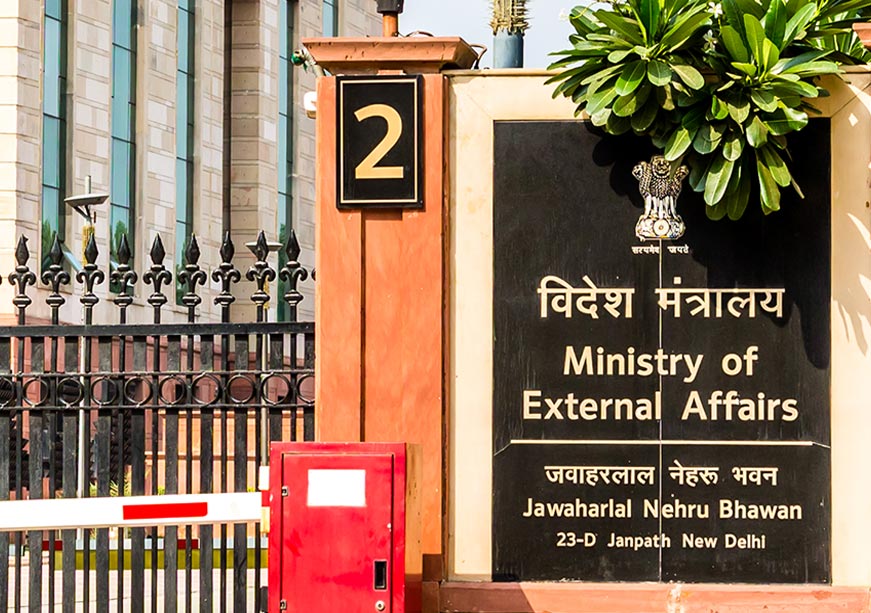-
CENTRES
Progammes & Centres
Location
MEA budget reflects geoeconomic shift, but institutional challenges persist.

Image Source: Getty
As the primary executive authority that formulates, implements, and pursues India’s foreign policy goals and the strategic objectives therein, the ministry of external affairs’ (MEA) annual budget merits a deeper analysis within the central government’s annual budgetary allocations. The foreign ministry’s budget not only reflects India’s strategic and international priorities but also New Delhi’s capacity to engage with its partners and deliver on its global ambitions and commitments.
While the MEA’s budget has increased by 67% between 2014 and 2025, its percentage share in the annual Budget has gone down from 0.8% to 0.4% in the same time-frame. This year, finance minister Nirmala Sitharaman allocated Rs 20,516.61 crore for the ministry, which is a 7.3% decrease from last year’s projected spending and 18% from the revised estimates for 2024-25. However, this excludes the Indian Exim Bank sovereign guarantees which drove higher spending in 2023-24 (Rs 9,013.72 crore) and 2024-25 (Rs 4,383.40 crore). There is no such allocation for 2025-26, thereby reflecting that the MEA’s budget rose by 15.45% over 2024-25. The provisioning for the Exim Bank remains a flexible process, subject to future needs, similar to the Indian Development and Economic Assistance Scheme provisions, which saw a marked decrease to Rs 25 crore this year from FY23 (Rs 2,350 crore) and FY24 (Rs 3,849 crore). The 2025-26 Budget pegged 33% (Rs 6,750 crore) of the MEA’s allocations to overseas development partnerships.
The foreign ministry’s budget not only reflects India’s strategic and international priorities but also New Delhi’s capacity to engage with its partners and deliver on its global ambitions and commitments.
The MEA’s 2025 budget underscores New Delhi’s strategic and geoeconomic priorities for the year ahead. The Budget focuses on India’s neighbourhood and connectivity initiatives for trade-related and strategic imperatives, and delineates a shift from purely aid-based economic cooperation to sovereign loans, aid, and lines of credit through special diplomatic expenditures, the MEA’s Indian Technical and Economic Cooperation (ITEC) programme, and aid for specific countries.
In the neighbourhood, Bhutan emerged as the largest beneficiary Rs 2,150 crore). Sri Lanka (Rs 300 crore), the Maldives (Rs 600 crore), and Myanmar (Rs 350 crore) saw increments of 18.3%, 33%, and 28.5% respectively in the 2025-26 Budget outlay. Dhaka and Kathmandu are poised to retain the same amounts as FY24, while Afghanistan saw its aid decline from Rs 100 crore to Rs 50 crore. Notably, Bhutan’s allocations constitute 39.2% of the total international aid (Rs 5,483 crore) and 49.5% of the aid disbursed in South Asia (Rs 4,320 crore).
Aid in the neighbourhood will be instrumentalised to develop hydel power plants, roads, bridges, integrated border checkpoints, housing, etc. alongside capacity-building, training programmes, and small-scale grassroots-level community development projects. New Delhi is bullish on the integrated electricity trade markers in the BBIN (Bangladesh, Bhutan, India, and Nepal) region, despite facing headwinds in Nepal and Bangladesh last year. Its budgetary allocations in Bhutan are reflective of India’s commitment to regional energy security and renewable energy development. In Myanmar, the increase in allocation may be used for furthering progress on the Kaladan multimodal project and the India-Myanmar-Thailand trilateral highway project. Similarly, the Budget maintained its allocation to the Iranian Chabahar port (Rs 100 crore), necessary for developing the Chabahar hinterland region and port infrastructure. The Chabahar port is critical to the International North–South Transport Corridor, a Eurasian corridor India is part of and actively pursuing although President Trump has decided to cancel the waiver it had given to India on financing and constructing the Chabahar Port as part of its “maximum pressure” policy toward Iran. The MEA’s budget provides continuity to an essential foreign policy strategy in India’s extended neighbourhood: creating strategic interdependencies for bolstering regional security and bolstering bilateral ties.
The Budget maintained its allocation to the Iranian Chabahar port (Rs 100 crore), necessary for developing the Chabahar hinterland region and port infrastructure.
Of note are also the increased discretionary spending measures such as the special diplomatic expenditures (Rs 4,900 crore) and the ITEC programme (Rs 6,375 crore). These allocations for discretionary spending can help India expand its global profile, public perception, and bilateral relations, especially when China is emerging as a major challenge in the neighbourhood and the world order is evolving in unpredictable ways. These discretionary spending mechanisms are essential to allow New Delhi room for geoeconomic and strategic manoeuvring in the broader milieu of international relations.
While the MEA’s budget and the allocations therein are commendable apropos of India’s increasing global heft, it falls short of addressing developments in new domains such as critical technologies and the primary capacity-building and under-capacity issue that is a structural problem plaguing the MEA’s functioning.
The MEA’s institutional capacity remains constrained, still the ministry saw a 11.4% year-on-year decrease in its training budget for 2025-26. The Indian Foreign Service is critically understaffed, with only 850 officers managing 193 embassies and consulates. Though annual recruitment has risen to 32-35 officers, it remains far below global counterparts like the US (100-350) and the UK (80-100). At this rate, India would take decades to reach an optimal 1,500 officers. To bridge this gap, the MEA should consider lateral hiring, integrating defence personnel and international relations experts, and engaging consultants strategically rather than as temporary appointees to enhance diplomatic effectiveness. Additionally, with new domains such as critical technologies and generative artificial intelligence acquiring a strategic dimension, lateral hiring and officers’ training need to focus on these domains through a foreign policy lens.
The MEA’s 2025-26 budget reflects India’s strategic shift towards regional connectivity, economic diplomacy, and geoeconomic influence. However, institutional capacity gaps, an understaffed diplomatic corps, and limited focus on emerging domains like critical technologies are persistent challenges. Addressing these issues through strategic hiring, training, and targeted investments is crucial for India’s global ambitions and for realising goals such as Viksit Bharat 2047.
This commentary originally appeared in Financial Express.
The views expressed above belong to the author(s). ORF research and analyses now available on Telegram! Click here to access our curated content — blogs, longforms and interviews.

Professor Harsh V. Pant is Vice President – Studies and Foreign Policy at Observer Research Foundation, New Delhi. He is a Professor of International Relations ...
Read More +
Prithvi Gupta is a Junior Fellow with the Observer Research Foundation’s Strategic Studies Programme. Prithvi works out of ORF’s Mumbai centre, and his research focuses ...
Read More +